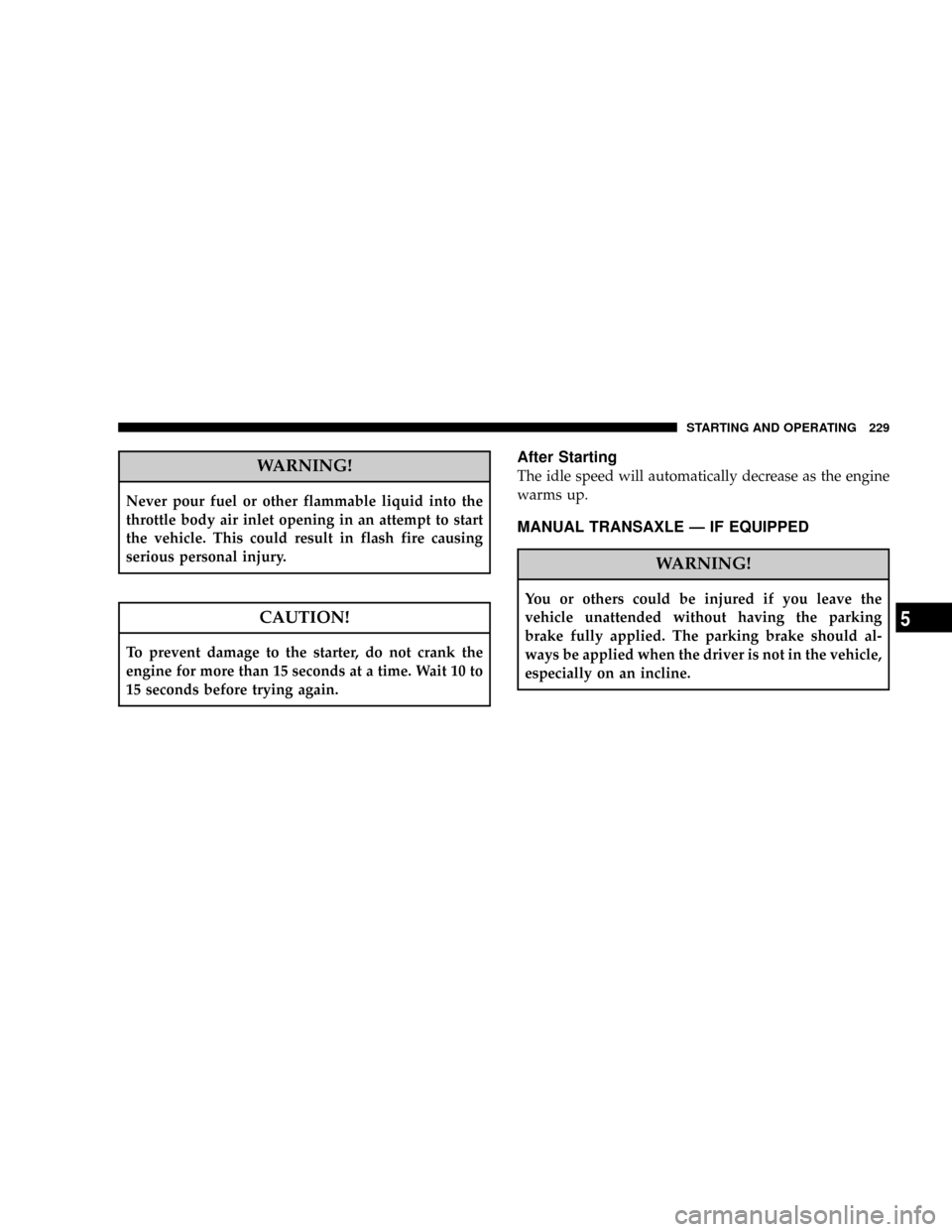JEEP COMPASS 2008 1.G Owners Manual
Manufacturer: JEEP, Model Year: 2008, Model line: COMPASS, Model: JEEP COMPASS 2008 1.GPages: 399, PDF Size: 6.59 MB
Page 221 of 399

Window Fogging
Vehicle side windows tend to fog on the inside in mild
rainy or humid weather. To clear the windows, set mode
to the mix or defrost position. Direct the panel outlets
toward the side windows. Do not use recirculate without
A/C for long periods as fogging may occur.
Interior fogging on the windshield can be quickly re-
moved by using the defrost position.
If the fogging problem persists, clean the inside window
surfaces. The cause of undue fogging may be dirt collect-
ing on the inside surface of the glass.
NOTE:In cold weather, the use of the recircu-
late position will cause windows to fog on the
inside because of moisture build up inside the
vehicle. For maximum defogging, press the
recirculation button until recirculate is off.
Summer Operation
Air conditioned vehicles must be protected with a high-
quality antifreeze coolant to provide proper corrosion
protection and to raise the boiling point of the coolant for
protection against overheating. A 50% concentration is
recommended.
Outside Air Intake
When operating the system during the winter months,
make sure the air intake, directly in front of the wind-
shield, is free of ice, slush, snow or other obstructions
such as leaves. Leaves collected in the air-intake plenum
may reduce air flow and plug the plenum water drains.
The blower air will heat faster in cold weather if you use
only a low blower speed for the first few minutes of
vehicle operation.
UNDERSTANDING YOUR INSTRUMENT PANEL 221
4
Page 222 of 399

Side Window Demisters
A side window demister outlet is at each end of the
instrument panel. These nonadjustable outlets direct air
toward the side windows when the system is in either the
FLOOR, MIX, or DEFROST mode. The air is directed at
the area of the windows through which you view the
outside mirrors.
222 UNDERSTANDING YOUR INSTRUMENT PANEL
Page 223 of 399

STARTING AND OPERATING
CONTENTS
mStarting Procedures.....................227
NManual Transaxle.....................227
NAutomatic Transaxle...................227
NNormal Starting......................227
NExtremely Cold Weather
(Below220ÉF Or229ÉC)................228
NIf Engine Fails To Start.................228
NAfter Starting........................229
mManual Transaxle Ð If Equipped...........229NRecommended Shift Speeds..............231
NDownshifting........................231
mAutomatic Transaxle Ð If Equipped.........232
NBrake/Transmission Interlock System.......233
NAutomatic Transaxle Ignition Interlock
System.............................233
NGear Ranges For Continuously Variable
Automatic Transaxle (CVT)..............234
mAutoStick Ð If Equipped.................236
NAutoStick Operation...................236
5
Page 224 of 399

NAutoStick General Information............237
mFour Wheel Drive Operation Ð If Equipped....238
mDriving On Slippery Surfaces..............238
NAcceleration.........................238
NTraction............................239
mDriving Through Water..................239
NFlowing/Rising Water..................240
NShallow Standing Water.................240
mParking Brake.........................241
mBrake System..........................243
NAnti-Lock Brake System (ABS) Ð
If Equipped.........................244
mPower Steering........................246mTire Safety Information...................247
NTire Markings........................247
NTire Identification Number (TIN)..........251
NTire Loading And Tire Pressure...........252
mTires Ð General Information...............256
NTire Pressure.........................256
NTire Inflation Pressures.................257
NRadial-Ply Tires......................259
NCompact Spare Tire Ð If Equipped.........260
NLimited Use Spare Ð If Equipped.........260
NTire Spinning........................261
NTread Wear Indicators..................262
NLife Of Tire.........................262
224 STARTING AND OPERATING
Page 225 of 399

NReplacement Tires.....................263
NAlignment And Balance.................264
mTire Chains...........................265
mTire Rotation Recommendations............265
mTire Pressure Monitoring System (TPMS) Ð
If Equipped...........................266
NBase System ± If Equipped...............269
NPremium System ± If Equipped...........271
NGeneral Information...................274
mSnow Tires...........................275
mFuel Requirements......................275
NGasoline Engines.....................275
NReformulated Gasoline.................276NGasoline/Oxygenate Blends..............276
NMMT In Gasoline.....................277
NMaterials Added To Fuel................277
NFuel System Cautions..................277
NCarbon Monoxide Warnings..............278
mAdding Fuel..........................279
NFuel Filler Cap (Gas Cap)...............279
NLoose Fuel Filler Cap Message............280
mVehicle Loading........................281
NGross Vehicle Weight Rating (GVWR).......281
mTrailer Towing.........................281
NCommon Towing Definitions.............281
NTrailer Hitch Classification...............284
STARTING AND OPERATING 225
5
Page 226 of 399

NTrailer Towing Weights (Maximum Trailer
Weight Ratings)......................285
NTrailer And Tongue Weight..............286
NTowing Requirements..................287
NTowing Tips.........................292mRecreational Towing (Behind Motorhome, Etc.) . . 293
NTowing This Vehicle Behind Another Vehicle
(Flat Towing With All Four Wheels On The
Ground)............................293
226 STARTING AND OPERATING
Page 227 of 399

STARTING PROCEDURES
Before starting your vehicle, adjust your seat, adjust both
inside and outside mirrors, and fasten your seat belts.
WARNING!
Never leave children alone in a vehicle. Leaving
children in a vehicle unattended is dangerous for a
number of reasons. A child or others could be seri-
ously or fatally injured. Don't leave the keys in the
ignition. A child could operate power windows,
other controls, or move the vehicle.
Manual Transaxle
Before starting the engine fully apply the parking brake,
press the clutch pedal to the floor, and place the gear
selector in N (Neutral).NOTE:The engine will not start unless the clutch pedal
is pressed to the floor.
NOTE:If key won't turn and steering wheel is locked,
rotate the wheel in either direction to relieve pressure on
the locking mechanism and then turn the key.
Automatic Transaxle
The gear selector must be in the P (Park) or N (Neutral)
position before you can start the engine. Apply the brakes
before shifting to any driving gear.
NOTE:You must press the brake pedal before shifting
out of P (Park).
Normal Starting
Normal starting of either a cold or a warm engine does
not require pumping or depressing the accelerator pedal.
Simply turn the ignition switch to the ªSTART'º position
and release when the engine starts. If the engine fails to
STARTING AND OPERATING 227
5
Page 228 of 399

start within 15 seconds, turn the ignition switch to the
ªOFFº position, wait 10 to 15 seconds, then repeat the
normal starting procedure.
WARNING!
Do not attempt to push or tow your vehicle to get it
started. Vehicles equipped with an automatic trans-
axle cannot be started this way. Unburned fuel could
enter the catalytic converter and once the engine has
started, ignite and damage the converter and vehicle.
If the vehicle has a discharged battery, booster cables
may be used to obtain a start from another vehicle.
This type of start can be dangerous if done improp-
erly, so follow the procedure carefully. See section 6
of this manual for jump starting instructions.
Extremely Cold Weather (below220ÉF or229ÉC)
To insure reliable starting at these temperatures, use of an
externally powered electric engine block heater (available
from your dealer) is recommended.
If Engine Fails to Start
If the engine fails to start after you have followed the
ªNORMAL STARTINGº procedure, it may be flooded.
Push the accelerator pedal all the way to the floor and
hold it there. Crank the engine for no more than 15
seconds. This should clear any excess fuel in case the
engine is flooded. Leave the ignition key in the ON
position, release the accelerator pedal and repeat the
ªNORMAL STARTINGº procedure.
228 STARTING AND OPERATING
Page 229 of 399

WARNING!
Never pour fuel or other flammable liquid into the
throttle body air inlet opening in an attempt to start
the vehicle. This could result in flash fire causing
serious personal injury.
CAUTION!
To prevent damage to the starter, do not crank the
engine for more than 15 seconds at a time. Wait 10 to
15 seconds before trying again.
After Starting
The idle speed will automatically decrease as the engine
warms up.
MANUAL TRANSAXLE Ð IF EQUIPPED
WARNING!
You or others could be injured if you leave the
vehicle unattended without having the parking
brake fully applied. The parking brake should al-
ways be applied when the driver is not in the vehicle,
especially on an incline.
STARTING AND OPERATING 229
5
Page 230 of 399

Fully depress the clutch pedal before you shift gears. As
you release the clutch pedal, lightly depress the accelera-
tor pedal.Use each gear in numerical order - do not skip a gear. Be
sure the transaxle is in 1st gear, (not 3rd), when starting
from a standing position. Damage to the clutch can result
from starting in 3rd gear.
For most city driving you will find it easier to use only
the lower gears. For steady highway driving with light
accelerations, 5th gear is recommended.
Never drive with your foot resting on the clutch pedal, or
try to hold the vehicle on a hill with the clutch pedal
partially engaged. This will cause abnormal wear on the
clutch.
Never shift into R (Reverse) until the vehicle has come to
a complete stop.
NOTE:During cold weather, until the transaxle lubri-
cant is warm, you may experience slightly higher shift
efforts. This is normal and not harmful to the transaxle.
5 ± Speed Shift Pattern
230 STARTING AND OPERATING